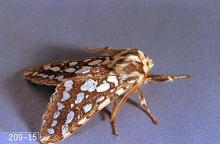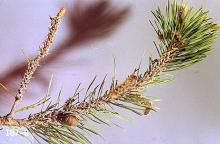Halisidota argentata
Pest description and crop damage Adult moths are brownish or tan with distinct silver-white spots on the wings. The caterpillars can reach 1.5 inches in length and are mostly reddish-brown with some blue-black or yellowish hairs.
The caterpillars of the silverspotted tiger moth feed on the needles, often "tenting" branches with dirty-looking webs. Feeding occurs through fall and winter, with webs becoming more noticeable by spring. Minor infestations cause little harm to trees. Douglas-fir is the preferred host, but pine, arborvitae, spruce, and true firs also are attacked.
Biology and life history Larvae hibernate in dense clusters on twigs and become active on warm winter days. Larvae mature in June.
Management-cultural control
Prune out and destroy tents with caterpillars. Caterpillar hairs can cause skin irritation if they are handled without gloves.
Management-chemical control
See:
Chemical Control of Nursery Pests
For more information
Johnson, W.T. and H.H. Lyon (1991), Insects That Feed on Trees and Shrubs, 2nd ed., Cornell University Press (p. 34).




